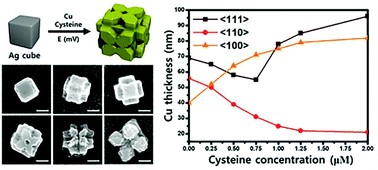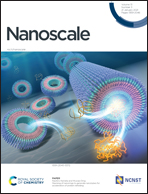Structural complexity induced by {110} blocking of cysteine in electrochemical copper deposition on silver nanocubes†
Abstract
Morphology evolution into intricate structures at the nanoscale is hard to understand, but we can get critical information from the combination of ex situ and in situ spectroelectrochemical techniques. In this study, we investigated the structural complexity generated during electrochemical Cu deposition on individual Ag nanocubes, which was driven by surface regulating cysteine molecules. During the deposition process, selective nucleation occurred on the Ag nanocubes by underpotential deposition, and then sequential structural evolution to a windmill morphology was observed. By adjusting the cysteine coverage, diverse structures were yielded, including face-overgrown, four-leaf clover, and octapod-like structures. Structural analysis along the crystallographic directions demonstrated that cysteine molecules exclusively blocked the growth along 〈110〉 and relatively promoted the growth along 〈100〉 and 〈111〉, respectively. Interestingly, all morphologies maintained a highly symmetric nature from the pristine cube, despite being diverse and sophisticated. These findings would be essential to design complex morphologies and achieve desirable optical and catalytic properties.



 Please wait while we load your content...
Please wait while we load your content...